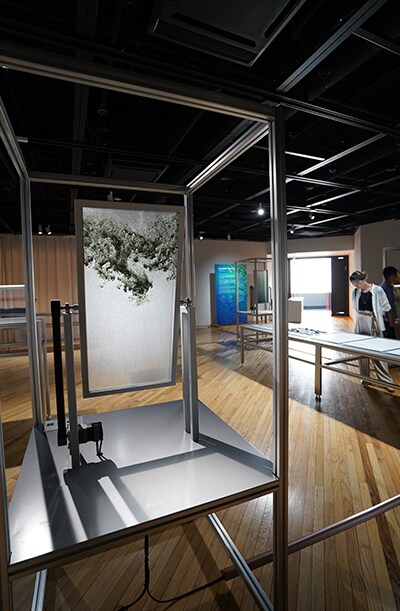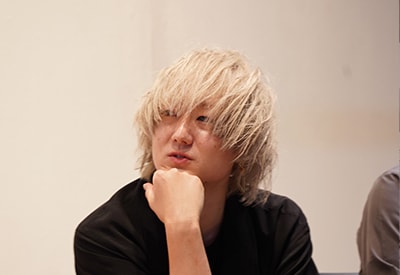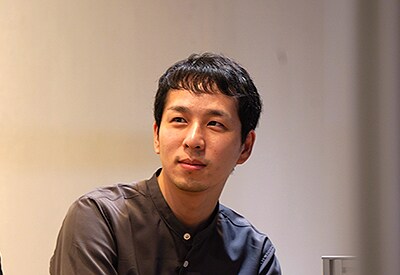Science Art "WONDER POWDER" Exhibited in Tokyo, the First Time in Japan
WONDER POWDER, science art born from the powerful imagination of Shimadzu designers, received special mention during Milan Design Week 2024 in April. In receiving this award, our artwork was selected as one of only 10 pieces out of more than 1,000 submissions in the interaction category of the Fuorisalone Award as a project that stimulates and fascinates people with its imaginative power, producing an immersive experience.
This article describes an event at the AXIS Gallery in Roppongi, Tokyo (October 11 to 15), where this artwork was exhibited for the first time in Japan.

- Overview of the Tokyo exhibition and the day of the event
- Methodology and background to collaboration with we+
- Challenges for the Shimadzu design team
- Interview with another collaborator with this project: Toyo Aluminum K.K.
- Discussion session: Atmospheric Studies and WONDER POWDER
- Receipt of the 2024 Good Design Award
- Comments from the Corporate Product Design Center members
Overview of the Tokyo exhibition and the day of the event

The Tokyo exhibit was convened with the objective of familiarizing the general public with Shimadzu, including Japanese designers and others unfamiliar with its products. During this event, many media representatives and designers visited, and WONDER POWDER provided an opportunity for lively discussions with these visitors.

The exhibition included hands-on artwork on the theme of "A fusion of art, science, and technology." When encountering this work, which was inspired by chromatography technology, Shimadzu’s flagship technology, participants were invited to touch the pieces freely, tilting them and watching the results, or spending a quiet and reflective time taking pictures and videos.

Visitors enjoy rotating their favorite pieces over and over.
Methodology and background to collaboration with we+
WONDER POWDER is a collaboration with "we+," a design studio that specializes in methods based on research and experimentation. Toshiya Hayashi of we+ notes that "We experimented with about 150 types of powdered materials, and selected patterns in combination with materials that behave beautifully in water. Ultimately 10% of the materials tested were used for the exhibit. Rather than using completely different types of materials, the most beautiful combinations of powders were of the same types, differing only slightly in specific gravity and particle size."



Rock pigments: Yamabuki yellow and Iwabeni red

Mica: Black and white
When the author asked whether they had considered using other liquids besides water, Hokuto Ando of we+ replied that "We wanted to emphasize beauty by focusing on identical conditions, the behavior of particles in water." Repeating their experiments while maintaining the same conditions is like what a scientist does, and Ando noted that "Art and science are quite similar."

Hokuto Ando (left) and Toshiya Hayashi of we+
Challenges for the Shimadzu design team
The design team at Shimadzu looked at what analytical instruments to use to investigate selected powdered materials, and whether the analytical results could be intuitively represented. Using a 3D printer to output the observation results from a scanning probe microscope, which observes the surface structure of a material, is a method for expressing analysis results that has never been tried at Shimadzu before. This representation combined the features of an instrument that can obtain 3D information with the fact that powders with smooth surfaces dance in the water like falling leaves.



Ryo Takegawa of the Product Design Group, and Tomoya Sugie of the UX Innovation Group, the Design Unit, Corporate Product Design Center
Interview with another collaborator with this project: Toyo Aluminum K.K.
Hirohisa Yamazaki and Rie Mukai of the Marketing Unit, Powder & Paste Headquarters, Toyo Aluminum K.K., visited the exhibit. Their company provided Chromashine®, a powdered material.
Toyo Aluminum K.K. manufactures aluminum foil for use as packing material for food items, pharmaceuticals, and electronic parts, as well as powder and paste products used as pigments and high functionality materials in cosmetics and automotive paints. Chromashine, the interference color aluminum pigment used in WONDER POWDER as one of the powdered materials, is a dye-free metallic pigment created using aluminum flakes as the base material. It has a number of vibrant color tones depending on how the light strikes it.

Hirohisa Yamazaki and Rie Mukai of Toyo Aluminum K.K. The artwork on the left uses Chromashine from Toyo Aluminum K.K.
Yamazaki and Mukai had the following to say regarding WONDER POWDER, which combines powdered materials and liquids.
Chromashine passes through a liquid state during the manufacturing process, so from our company’s perspective, this is a familiar scene. There had never been an occasion in-house to address how interesting or beautiful it looks, so this has made us think about whether there are any potential applications. Creating artwork like this has given us ideas about future developments for Chromashine, which I think is great.
- *Chromashine® is a registered trademark of Toyo Aluminum K.K in Japan.
Discussion session: Atmospheric Studies and WONDER POWDER
In this discussion session, associate professor Yuho Hisayama of the Graduate School of Humanities, Kobe University, a representative of the Kobe Institute of Atmospheric Studies (KOIAS), as well as Hayashi and Ando from we+, and Takegawa and Sugie of Shimadzu’s Corporate Product Design Center talked about WONDER POWDER and atmospheric studies.
This discussion began by defining atmospheric studies. The atmosphere felt at the WONDER POWDER exhibit was then discussed in terms of microparticles, time, and location. From time to time, the discussion session took on the atmosphere of a university lecture by Associate Professor Hisayama, as he piqued the interest of the participants. A lively discussion with the participants continued regarding atmospheric studies and WONDER POWDER even after the session ended.

Discussion session

Associate Professor Yuho Hisayama, representative of the Kobe Institute for Atmospheric Studies (KOIAS)
Receipt of the 2024 Good Design Award
"WONDER POWDER" received the Good Design Award in 2024. This award, the only comprehensive design evaluation and promotion mechanism in Japan, has continued for more than 60 years. The WONDER POWDER panels were exhibited at the 2024 Good Design Award Exhibition (11/1 to 11/5 at Tokyo Midtown (Roppongi).
WONDER POWDER exhibit (shot in Milan)
WONDER POWDER manufacturing process
Comments from the Corporate Product Design Center members
Ryo Takegawa
This project began with the idea of sharing Shimadzu’s attractiveness with more people. After this exhibition in Japan, a number of acquaintances connected with design said that Shimadzu WONDER POWDER had made quite an impression, and that it really seemed to have increased our popularity and image. This initiative has served as an opportunity for many people to learn of Shimadzu’s existence from a new perspective, and I feel that it has been a very significant project.
Tomoya Sugie
The exhibit in Milan was favorably received, and many enthusiastic calls for a Japanese showing resulted in this domestic exhibition. Many manufacturers also visited this exhibit, as did customers who are using Shimadzu analytical instruments. Their surprise at seeing that analytical techniques could be used in such a way was impressive. I am glad that we could showcase Shimadzu’s technological and design capabilities to a variety of people including students.
 Page Title and URL Copied.
Page Title and URL Copied.


